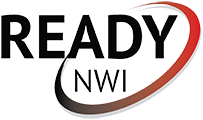Written by: Jennifer Bissonnette
Within the next 10 years, it’s estimated that there will be more than one million jobs to fill in Indiana due to retiring employees and new job creation. According to the Indiana Department of Workforce Development, nearly half of these jobs will require some training beyond high school, but less than a four-year-degree. So the question remains, how do we meet this need?
To start answering this question, Indiana’s Office of Work-Based Learning and Apprenticeship (OWBLA) is touring the state to talk about the future of employment in Indiana. On Wednesday morning, the Center of Workforce Innovations hosted Darrel Zeck, OWBLA Executive Director, and Carrie Lively, OWBLA Senior Director, to speak with local employers and educators.
“The purpose of the office, one of the main objectives, is to develop work-based learning pathways for both educators and employers,” Zeck said. “This is a way for us to get out into the regions and let them know what it is that we’re doing in the realm of work-based learning and apprenticeships.”
Zeck and Lively discussed barriers in filling these future roles in the workforce and how these gaps could begin to be filled by offering work-based learning and apprenticeship programs. In the State of Indiana, students will soon be required to partake in graduation pathways requirements, much of which are aimed at aiding the job force and getting students exposure to potential career paths.
“The reason that it’s important at this point in time in Indiana is largely to do with the shift nationally around work-based learning and seeing that as a viable option for students and adults,” Lively said. “With our new graduation pathways for the State of Indiana…this is an opportune time for us to talk with people about what work-based learning is.”
True change is on the way in work and education. Part of the morning’s meeting focused on the fact that a four-year degree is not always required for high-paying jobs in the state, and that apprenticeship and trade positions should not be looked down on. The end goal, after all, is that everyone ends up in a career they love.
“Building that 21st Century, skilled workforce in the State of Indiana is important,” Zeck said. “I was an employer four months ago, and certainly human capital was the number one barrier to business sustainability and growth.”
Many in attendance found their way to the meeting to voice their concerns and ask questions regarding human capital and what the Department of Workforce Development will be doing around the state to address issues in hiring and skills gaps. R.D. Parpart, Manager of USA Craft Training for ArcelorMittal, also handles workforce development and has found that hiring is one of their greatest barriers.
“Jobs today are a lot different than they were 50 years ago,” Parpart said. “We’re trying to see what we can do to get more people into the industry, into manufacturing, and students into careers that don’t require a four-year degree. We’re seeing what we can do to build our pipeline for the future.”
The meeting focused on educating both employers and educators on what can be done to create a pipeline of human capital for businesses in Indiana. Through education, exposure, and early learning opportunities, it’s believed that filling these open jobs in the future will be successful, which is something the Center of Workforce Innovations strives to assist with.
To contact Darrel Zeck regarding information, please email dzeck@dwd.in.gov.
View full article on NWIndianaLife here
Copyright © 2018 Ideas in Motion Media

